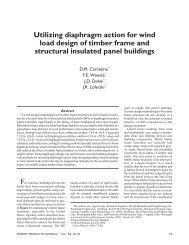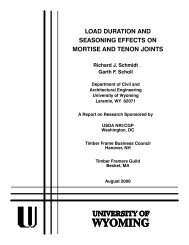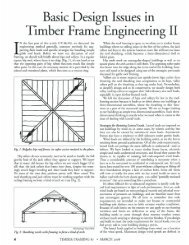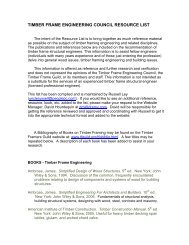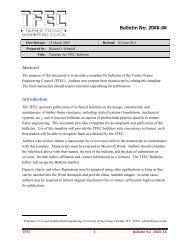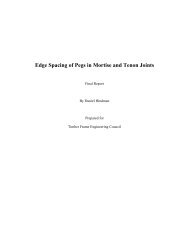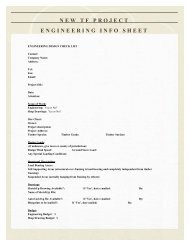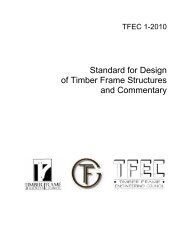Timber Frame Tension Joinery - Timber Frame Engineering Council
Timber Frame Tension Joinery - Timber Frame Engineering Council
Timber Frame Tension Joinery - Timber Frame Engineering Council
You also want an ePaper? Increase the reach of your titles
YUMPU automatically turns print PDFs into web optimized ePapers that Google loves.
shoulder that can carry the entire width of the beam perform better under gravity loads than<br />
unshouldered mortise and tenon connections or fork and tongue-type connections. An<br />
overall impression from these tests is that these joints have remarkable load capacity and<br />
resistance to catastrophic failure (Sandberg et al., 1996).<br />
Preliminary work done at the University of Wyoming on the design of tension<br />
joinery was discussed in (Schmidt et al., 1996). Emphasis was on the applicability of the<br />
NDS yield modes to all-wood connections and the presentation of material strength test<br />
data.<br />
Other research efforts in the U. S. have focused on peg characteristics and joint<br />
design. An investigation of dowel bearing strength for pegged joints was performed at the<br />
University of Idaho by J. R. Church (Church and Tew, 1997; Church, 1995). Church<br />
performed bearing tests on Red Oak and Douglas Fir specimens using White Oak pegs.<br />
One of his findings was that the bearing strength of both materials was higher when the peg<br />
was loaded in the radial orientation (perpendicular to growth rings) than when loaded in the<br />
tangential orientation, regardless of the orientation of the base material. Another finding<br />
was that the bearing strength of the Red Oak was independent of the base material<br />
orientation. That is, dowel bearing strength parallel to the grain is not significantly higher<br />
than that perpendicular to the grain when the dowel consists of a white oak peg. Also there<br />
seemed to be no significant effect from the variation in hole size for a given peg size.<br />
A program of joint specimen tests and analytical analysis for timber bridge<br />
construction was performed at the Massachusetts Institute of Technology (Brungraber and<br />
Morse-Fortier, 1996). Both of these studies have produced valuable data regarding the<br />
bending, shear and bearing characteristics of hardwood pegs.<br />
7




